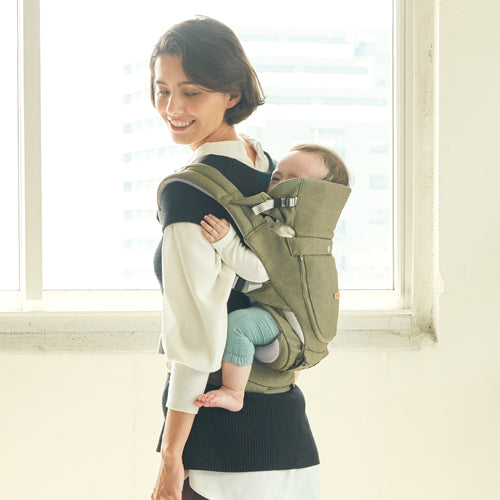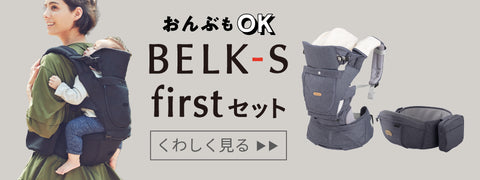When can you start piggybacking? How to choose a piggyback string or baby carrier and precautions
A few years ago, it was common for babies to be carried on their backs. "Baggy straps" didn't even exist, but now they've been completely reversed. Although it is rare to see moms and dads carrying their babies on their backs anymore, there are some advantages to carrying a baby on their back. This time, while introducing the good points of piggyback riding, we will also talk about how many months after birth you can start carrying your baby, compare the advantages and disadvantages of piggyback riding and carrying, and talk about the differences between piggyback straps and baby carriers, and how to choose one.

Wait until your baby's neck is sitting before piggybacking.If you force your baby into an unreasonable position before then, not only will it put a big strain on your baby's body, but you may even get injured.
Each has its own advantages and disadvantages, so it's a good idea to use a piggyback string or a baby carrier depending on the situation.The dual-purpose type is convenient and can be used for carrying on your back or in your arms.
It is important to choose something that is comfortable for both baby and mom and dad to use in a comfortable position, something that is safe so you don't have to worry about it breaking or falling, and something that is easy to put on and take off.
1. When can you start piggyback riding?
 Piggyback riding is carried out only after the neck is completely seated.
Piggyback riding is carried out only after the neck is completely seated.
Piggyback riding is convenient for moms and dads, as both hands are free, making it easier to do housework and other tasks.
However, it is no good to suddenly put a newborn baby on your back. Wait until your baby's neck is completely seated before giving your baby a piggyback ride.
A newborn baby's neck muscles are not fully developed, so they are unable to support their heavy head on their own. As children develop, they become able to support and move their heads on their own, but this“My neck is stiff.”That's what it means.
A shaky head can cause damage to the muscles and nerves in your neck, as well as brain damage. You should refrain from giving your baby a piggyback ride until the baby's neck is stable, and be careful when holding your baby upright, such as by placing your hand on the baby's head.
Approximate sitting position
The approximate time for a baby to sit up is said to be around 3 to 4 months old.
Of course, this varies from person to person, so some children may be able to hold their heads sooner, while others may take more than 5 months. There's no need to worry too much about whether it's late or early.
Whether your neck is sitting or not,
①Can you lift your head while lying on your stomach?
② When you lift your arms up from a supine position, does your head follow your upper body without hanging backwards?
Check. If you are unsure about checking it yourself, it would be a good idea to have it checked at your 3-4 month checkup.
2. Piggyback strings and baby carriers, each with their own unique characteristics
 Piggyback straps have a simpler structure than baby carriers, and are often lightweight and foldable.
Piggyback straps have a simpler structure than baby carriers, and are often lightweight and foldable.
Just as carrying a heavy item on your back makes you feel more comfortable, carrying your baby on your back is easier for parents than carrying them. Since the baby and mom and dad are facing the same direction, the baby's body naturally fits the curve of mom and dad's back, providing excellent stability. It is a comfortable position that puts less strain on the baby.
However, since you can't see what's going on with your baby, it's essential to check on it frequently. Use a mirror to check your baby's position, complexion, and facial expressions. It is important not to keep your baby on your back for long periods of time, and to take a break from time to time.
On the other hand, the advantage of holding your baby is that you can always keep an eye on your baby and it is easy to communicate with them. You can also use a baby carrier to free up your hands. There are many different types of baby carriers, from simple ones like slings to more sturdy ones like hip seat carriers.
Because the baby is in the front of your body, it is easier to feel the weight of the baby than in a piggyback ride, and it must be said that it is not as easy to do housework and other tasks.
There are advantages and disadvantages to both piggyback riding and cuddling, so it is difficult to say which is better. It is a good idea to use different types depending on the baby's growth rate and the situation at the time.
It can also be used as a piggyback ride! BABY&Me hip seat carrier
BABY&Me's hip seat carrier can be used not only for carrying but also for piggyback riding.
The BELK-S first set, which can be used for face-to-face carrying from newborn babies, can adjust the opening of the baby's legs, tightly wraps around the baby's bottom, and gently supports the waist, so it can also be used as a piggyback as long as the baby's neck is seated. From around 7 months old, after your baby has sat down, you can remove the first part and switch to the hip seat for piggyback riding.


The hip seat can also be used alone, and is useful for supporting breastfeeding before sitting up, and helping to reduce the burden on moms and dads when laying them down to sleep.

A major feature of BABY&Me's hip seat carrier is that it can be used for a long time from the newborn stage, as it can be used differently depending on the child's growth level and situation.
3. Points to consider when choosing a piggyback string or baby carrier
Both piggyback straps and baby carriers are used almost every day to lift and carry babies, so it is important that they are safe and comfortable, and that they are easy to use for moms and dads.
It is essential that it has a shape that fits the baby's body, has a solid structure, and is durable enough to not break easily. In order to eliminate the risk of unexpected accidents and reduce the burden on the baby and mom and dad, it is important to be able to hold or carry the baby in close contact.
The Hip Seat Carrier is a baby carrier with a ``hip seat'' that firmly lifts your baby's butt. The baby can be held in a comfortable position, and the hip seat firmly supports the baby's weight, reducing the strain on the shoulders and lower back of moms and dads compared to traditional baby carriers. It is also very important that it is easy to put on and take off.
Your baby will get tired if they stay in the same position for long periods of time, so it is important to take frequent breaks while carrying your baby on your back or in your arms. Choose one that is easy and safe to put on and take off.
Another important thing is the material.
During the cold season, you can protect yourself from the cold by adding a cape, but in the hot season, if you stay in close contact with your clothes, you will inevitably sweat. Materials such as mesh are good because they are breathable and dry easily so you don't get stuffy or get heatstroke.
When you open the zipper on the back of BABY&Me's hip seat carrier, it becomes mesh, and the cover can be rolled up and stored, so it can be used comfortably in all seasons.

Summary
After about 4 months of age, when your baby can sit upright, you will be able to carry them on your back. Prepare baby carriers and piggyback straps so that you can carry your baby on your back or carry him on your back depending on the situation. There are also products that can be used for both, so we recommend them. Please choose a product that will make your life with your baby happier by carefully considering safety, comfort, and ease of use such as ease of putting on and taking off.
































